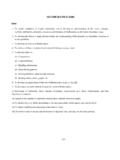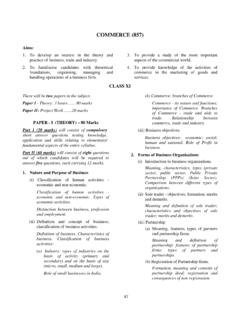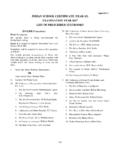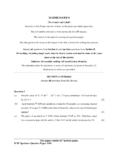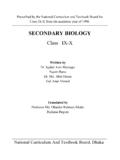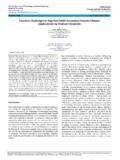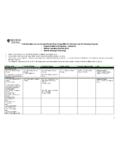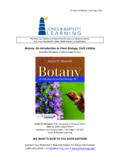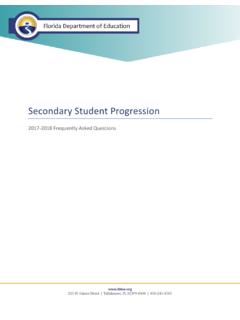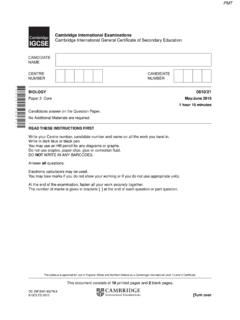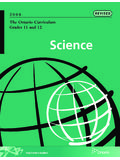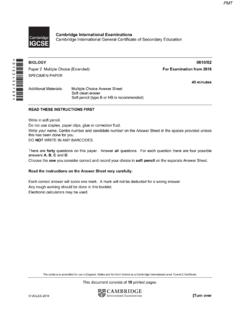Transcription of CORRIGENDUM: BIOLOGY PRACTICAL (PAPER 2)
1 corrigendum : BIOLOGY PRACTICAL ( paper 2). Please be informed that the break up of marks for the assessment of Project Work and the PRACTICAL File for BIOLOGY stands revised for the ISC Examination to be held in and after the year 2017. In the previous years, 10 marks (7 marks for Project work and 3 marks for PRACTICAL file) out of 30 marks were assigned for the Internal Assessment. However, the same stands revised as follows: Project work (to be assessed by the Visiting 10 marks Examiner). PRACTICAL File (to be assessed by the Visiting 05 marks Examiner). Total 15 marks In view of the change in the break-up of marks in the assessment of the Project Work and the PRACTICAL File, the PRACTICAL Papers in BIOLOGY will now be assessed externally out of 15 marks, instead of 20 marks. BIOLOGY (863). Aims: 1. To enable candidates to acquire the knowledge and to develop an understanding of biological terms, concepts, facts, principles, formulae, etc.
2 2. To develop the ability to apply the knowledge of BIOLOGY in unfamiliar situations. 3. To develop experimental skills required in BIOLOGY PRACTICAL work. 4. To create awareness about the problems of the environment and the manner in which these problems can be overcome. 5. To develop the ability to appreciate biological phenomena in nature and the contribution of BIOLOGY to human welfare. 6. To develop interest in plants and animals and in their respective environments. 7. To develop scientific attitude towards biological phenomena. 8. To create awareness of the fundamentals of human BIOLOGY , food, health, nutrition and population control. CLASS XI. There will be two papers in the subject. paper I: Theory: 3 hours ..70 marks paper II: PRACTICAL : 3 hours ..20 marks Project Work 7 marks PRACTICAL File 3 marks paper 1- THEORY: 70 Marks There will be no overall choice in the paper . Candidates will be required to answer all questions. Internal choice will be available in two questions of 2 marks each, two questions of 3 marks each and all the three questions of 5 marks each.
3 UNIT TOTAL WEIGHTAGE. 1. Diversity of Living Organisms* 07 + 10* Marks 2. Structural Organisation in Animals and Plants 11 Marks 3. Cell: Structure and Function 15 Marks 4. Plant Physiology 17 Marks 5. Human Physiology 10 Marks Total 70 Marks *The topic Biological Classification under Unit 1 Diversity of Living Organisms is to be assessed through Text Based Assessment which will include questions of 10 Marks. No other questions will be asked from this section. The material for Text Based Assessment is to be prepared by the school. PLEASE NOTE: The topic for Text Based Assessment may vary from one year to another 190. paper I THEORY 70 Marks shape, nutrition and mode of respiration;. types of reproduction definition of Note: All structures (internal and external) are fission, conjugation, transduction and required to be taught along with diagrams. transformation (details not required). Economic importance with reference to role of bacteria in sewage treatment, 1.
4 Diversity of Living Organisms antibiotics, energy production and house (i) The Living World hold products (curd and cheese only). What is living? Biodiversity; Need for (c) Kingdom Protista only two general classification; three domains of life; characteristics and two examples taxonomy and systematics; concept of of subgroups: (i) Chrysophytes species and taxonomical hierarchy; (ii) Dinoflagellates, (iii) Euglenoids, binomial nomenclature; tools for study of (iv) Slime moulds, (v) Protozoans (to be taxonomy-museums, zoological parks, studied under rhizopods, flagellates, herbaria, botanical gardens. ciliates and sporozoans with two Characteristics of living organisms. characteristics including modes of Biodiversity (definition only). Need for locomotion and two examples of each). classification should be discussed. Three (d) Kingdom Fungi: general characteristics domains of life distinguishing features of and mode of reproduction of each (archaea, bacteria, eukarya), - a brief idea of (including types of spores and sexual the role of different types of archaebacteria reproduction definition of isogamy, (methanogens, halophiles and anisogamy, oogamy, plasmogamy, thermoacidophiles in their extreme karyogamy and dikaryophase).)
5 Environments, mycoplasma three distinctive Zygomycetes, Ascomycetes, features). Definition and explanation of the Basidiomycetes, Deuteromycetes - terms taxonomy and systematics. Concept of characteristics with examples. Role of species. Major taxonomical hierarchies fungi in the field of medicine, bakery and (phylum, class, order, family, genus, environmental decomposition. Definition species): definition and examples with of lichens and mycorrhiza (ecto and reference to classification of man, house fly, endo). mango and wheat. Rules of binomial nomenclature and advantages of using Life cycles not required. scientific names. Aids for study of taxonomy (e) Virus (characteristic features link a very brief idea of museum and herbaria, between living and non-living, structure zoological parks and botanical gardens. of TMV and bacteriophage and Definition of taxonomical keys. contribution of the following scientists: Three systems of classification artificial, Ivanowsky, Beijerinck, natural and phylogenetic.
6 Stanley) and Viroid (definition only). (ii) Biological Classification (iii) Plant Kingdom Five kingdom classification; s alient features and classification of Monera, (a) Algae - characteristics (morphology, Protista, Fungi, P l a n t a e and Animalia. common name, major pigments, stored Lichens, Viruses and Viroids. food, composition of cell wall, flagellar number and position of insertion, habitat, (a) Five-kingdom system of classification mode of sexual reproduction . and characteristics of different kingdoms isogamous, anisogamous and oogamous). with examples. and examples of Chlorophyceae, (b) Kingdom Monera: Bacteria - Phaeophyceae, Rhodophyceae; Economic classification of bacteria according to importance of algae any five. 191. (b) Bryophyta general characteristics, mammalia) three distinguishing characters distinctive features of liverworts and with two examples of each). mosses; graphic outline of life cycle of 2. Structural Organisation in Animals and Plants Funaria with reference to alternation of generations.
7 Economic importance of (i) Morphology of Flowering Plants bryophytes. (a) Morphology and modifications of root, (c) Pteridophyta: characteristics; stem, leaf. classification into classes: psilopsida Types of roots (tap, fibrous, adventitious), (Psilotum), lycopsida (Selaginella, regions, modifications of roots for Lycopodium), sphenopsida (Equisetum) storage, respiration (pneumatophores). and pteropsida (Dryopteris, Pteris and and support (stilt and prop). Adiantum). Graphic outline of life cycle of a typical pteridophyte (fern). Definition Stems features (nodes internodes, of homospory and heterospory with buds), modifications underground, relevant examples. Economic importance. aerial and sub-aerial. (d) Gymnosperms: general characteristics Leaves - parts of a simple leaf, venation, and graphic outline of life cycle of a types of leaves (simple and compound . typical gymnosperm (Pinus). Economic pinnate and palmate), phyllotaxy . importance.
8 Alternate, opposite, whorled (with an example of each). (e) Angiosperms general characteristics and classification into monocots and Modifications for mechanical support, dicots; Graphic outline of life cycle of a protection, storage, reproduction;. typical angiosperm. insectivorous plant (pitcher plant, Venus-fly-trap. (f) Comparison of life cycle patterns of different plant groups (haplontic, (b) Morphology of flower, fruit and seed. diplontic and haplo-diplontic). Structure of a typical flower, types of inflorescence (racemose and cymose). (iv) Animal Kingdom Structure of a typical flower, Animal Kingdom: animal construction - body bracteates/ebracteate, [symmetry plan (cell aggregate plan, blind-sac plan and (actinomorphic, zygomorphic), tube-within-tube plan), symmetry (spherical, trimerous/tetramerous/pentamerous radial and bilateral symmetry), coelom complete/ incomplete, non-essential development (diploblastic and triploblastic whorls (calyx: gamosepalous, organisation in animals, acoelomate, polysepalous, corolla: gamopetalous, pseudocoelomate, coelomate and polysepalous, perianth), essential whorls haemocoelomate), segmentation.)]
9 (androecium: cohesion - syngenesious, Non-chordata - five distinguishing synandrous, monadelphous, diadelphous, characters with two examples of Porifera, polyadelphous; adhesion epipetalous, Cnidaria, Ctenophora, Platyhelminthes, epiphyllous; number of lobes . Nematoda (Aschelminthes), Annelida, monothecous, dithecous; Gynoecium: Mollusca, Arthropoda, Echinodermata, position of ovary epigynous, Hemichordata. hypogynous, perigynous, cohesion . apocarpous, syncarpous, number of Chordata sub-classification of Chordata locules unilocular, bilocular, with reference to notochord - sub phyla multilocular], types of inflorescence Urochordata, Cephalochordata. Vertebrata (racemose and cymose definition and (classes cyclostomata, chondrichthyes, differences; subtypes not required). osteichthyes, amphibia, reptilia, aves and 192. Fruits to be classified into true and false, Location, structure and functions of structure of a typical fruit (mango and epithelial tissues with examples, types coconut).))
10 Of junctions (tight, adhering and gap Seeds structure of dicot (bean) and junctions) location and general monocot (maize), non-albuminous and structure of areolar tissue - functions of albuminous, perisperm. different types of cells; difference Description of families Solanaceae, between bone and cartilage; of Fabaceae and Liliaceae. hyaline cartilage, of bone, (to be (ii) Anatomy of Flowering Plants taught with the help of diagrams);. (a) Plant Tissues: types of plant tissues: different types of muscles and their Meristematic tissues: classification of functions; structure of a neuron (types meristematic tissue. Permanent Tissues: unipolar, bipolar, multipolar, structure and function of simple tissues myelinated, non-myelinated). (parenchyma, collenchyma and Neuroglial cells. sclerenchyma) and complex tissues (b) Cockroach (xylem and phloem), tissue system. Morphology, anatomy and functions Internal structure of root, stem, and leaf.
